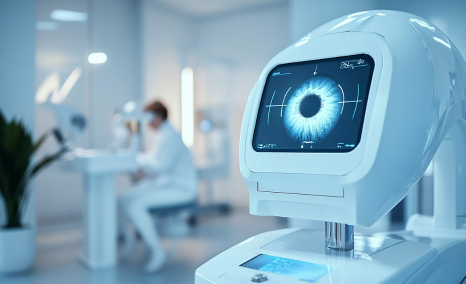Insights Into the Evolving Landscape of the Ocular Implants Market
Jan 04, 2023
Table of Contents
Vision loss or vision impairment is one of the major issues globally that can affect people of all ages. As per the WHO, Globally, about 2.2 billion people have a near or distance vision impairment. Moreover, in almost half of the cases, vision impairment could have been prevented or has yet to be addressed. It is observed that uncorrected refractive errors, age-related macular degeneration, glaucoma, cataracts, and diabetic retinopathy are the leading cause of vision impairment, and the number of cases of vision impairment is growing exponentially. Vision impairment can lead to an intense financial and social burden on the person and their families. As per the estimate, the annual global cost of productivity losses associated with vision impairment is around US$ 411 billion, which is anticipated to grow in the coming years with the rising number of cases. To improve the treatment scenario and address the unmet needs, globally, several major pharma and biotech giants are actively working in the therapeutics market to develop new drug candidates. Similarly, several key MedTech players are active in the devices and product development segment to develop novel drug delivery technologies and are exploring different ways to restore sight. Ocular Implants are one of the key products which are in high demand in the eye care segment. Ocular implants are being extensively used to treat both posterior and anterior segment eye diseases. Similarly, they can fix some forms of vision impairments such as glaucoma, presbyopia, myopia, etc. As per the DelveInsight, the demand for Ocular Implants is growing at a tremendous rate owing to the rise in the cases of eye disorders, a rising population of geriatric people around the world, and technological advancements in product development, among others.
What are Ocular Implants?
Ocular implants are small devices designed to be inserted into the eye to restore the sharpness of vision and deliver a drug locally over an extended period. Ocular implants present a unique solution to the challenges of treating posterior eye disorders. Most Ocular Implants are made of a synthetic material called porous polyethylene or hydroxyapatite. However, some of the Ocular Implants are also made up of medical-grade plastic acrylic. Ocular implants form a part of surgical procedures that help fix cataracts and other vision impairments such as glaucoma, presbyopia, myopia, etc. The surgeon may elect to wrap the implant with a material such as an eye bank (cadaver) so the prosthetic eye moves more naturally. The demand for Ocular Implants is growing rapidly as a treatment option as patients continue to look for a convenient and less invasive treatment option.
Downloads
Click Here To Get the Article in PDF
Recent Articles
- What can be the scope of Medical Marijuana?
- Anterior Uveitis: A Vision-threatening condition
- Analyzing the Most Promising Drugs That Will Lose Patent in the US & EU in 2022
- Contact Lenses: A Comprehensive Guide to Vision Correction and Beyond
- Abbott’s Alinity m STI Assay; Phillips’ MR 7700 System; HOYA’s MiYOSMART Spectacle Lens; Magneto’...
Ocular Implants Product Types and Application
Currently, ocular implants have been extensively used to treat both posterior and anterior segment eye diseases. Several types of Ocular Implants are already commercially available in the market to cater to different needs. Ocular Implants can be segmented into various types based on the application, their uses, and materials. As per the product types, they are segmented as intraocular lenses, corneal implants, glaucoma implants, orbital implants, and ocular prosthesis. Similarly, as per the application types, the Ocular Implants are classified as cataract, glaucoma surgery, macular degeneration, oculoplasty, drug delivery, and others. Moreover, by material, the Ocular Implants are segmented as biodegradable (bioresorbable) and non-biodegradable (biodurable). Bioresorbable implants are inserted into the patient’s eye and safely absorbed by the body over time. These implants combine a drug with a polymer that degrades over time, releasing a drug.
As per DelveInsight’s assessment, based on the application segment of the Ocular implants market, the cataracts category is projected to register significant growth in terms of revenue in the Ocular implants market during the forecast period (2022-2027). The cataracts category is anticipated to register high growth owing to the increase in the prevalence of cataract cases worldwide, which lead to serious consequences of total vision impairment and moderate to severe visual impairment (MSVI). Moreover, the risks of cataracts and blindness also increase with several factors, the strongest factor being age. Considering the growing demand for cataract-related ocular implants, various new products are expected to get launched in the market with technological advancements in the upcoming years.
Ocular Implants – Major Benefits and Drawbacks
Ocular Implants are required to be tolerable and made up of appropriate size, shape, and power for use by the individual patient. Today, several different types of Ocular Implants are available in the market. Ocular Implants can increase dosing accuracy with controlled drug delivery and overcome the side effects of pulsed dosing produced by conventional formulations. Ocular Implants allow drug delivery at therapeutic levels directly into the target site. Moreover, the Ocular Implants provide comfort, better patient compliance, and improved therapeutic performance of the drug as compared to intravitreal injections and systemic administration. The development of Ocular Implants requires extreme precision and care throughout the development stage and production. A small change in drug concentration or implant dimensions can severely impact product performance.
As per the material types, the Ocular implants come in biodegradable (bioresorbable) and non-biodegradable (biodurable) forms. Each type of implant has several types of advantages and disadvantages associated with them. Biodurable implants do not break down over time and may be removed or refilled once the treatment is complete. Bioresorbable implants eliminate the need for patients to undergo a follow-up procedure, but they may not be suitable for use with all drugs. Biodurable implants can offer longer, more controlled drug release, but they may require patients to undergo a second procedure to remove them.
Ocular Implants Market Dynamics
One of the noteworthy drivers for the growing demand for Ocular Implants is the rise in the rising prevalence of eye disorders such as cataracts, glaucoma, presbyopia, and myopia. As per the estimate, the prevalence rate of unaddressed cataracts and glaucoma in the year 2020 was 94 million and 7.7 million, respectively. The number of refractive errors, such as myopia and presbyopia, is also anticipated to increase in the upcoming years. According to the National Eye Institute (2022), refractive errors such as presbyopia affect 100% of the population in people aged above the range of 55–65 years. Additionally, the rise in the geriatric population worldwide is also stimulating the cases of eye disorders, thereby driving the ocular implant demand. The constant technological advancement in Ocular Implants development, such as enhanced product design, safety, and biocompatibility, are also stimulating the Ocular Implants market growth. However, despite several favorable factors, some of the key aspects, such as the side effects associated with cataract and glaucoma surgeries which can result in long-term hindrances to vision, a lack of skilled workforce along with low rates of diagnosis, are predicted to hamper the Ocular Implants market growth.
Recent Clinical, Commercial and Regulatory Developmental Activities in the Ocular Implants Market:
- In April 2022, STAAR SURGICAL announced the launch of the EVO Vision Implantable Collamer Lens at the American Society of Cataract and Refractive Surgery Annual Meeting (ASCRS) in Washington, D.C.
- In November 2021, Alcon Inc. took over Invantis Inc., which specializes in glaucoma ocular devices that are micro-invasive, in California to expand its glaucoma surgical implants segment.
- In August 2019, Alcon gained FDA approval for its AcrySof PanOptix Trifocal lens, which is the first and only Trifocals lens in the U.S.
- In September 2020, Hoya Surgical Optics, a part of Hoya Corporation, announced the global launch of the CLEAR log in Singapore. It is a specialized next-generation technology application designed to analyze the clinical results and outcomes of cataract and Refractive Lens Exchange Surgery.
- In March 2020, Allergan, which is a part of a US-based multinational company AbbVie, received FDA approval for its product DURYSTA, which is used for the reduction of Intra-ocular pressure in patients suffering from open-angle glaucoma or ocular hypertension.
Regional Market Assessment and Key Companies in the Ocular Implants Market
As per the assessment, among all the regions, North America is anticipated to lead in the global Ocular Implants market in terms of revenue generation. The growing prevalence of eye disorders and refractive errors is one of the key factors for the high growth. A high consumer awareness, technological advancement in product development with increased safety and biocompatibility of implants, new product launches, and the presence of major players in the region are also anticipated to drive the growth of the North America Ocular Implants Market. Due to the presence of a large patient pool in the United States, many ocular implants are getting FDA approvals for their commercial use in markets.

Globally, some of the prominent players in the Ocular Implants market include Alcon, Johnson & Johnson, Bausch Health Companies, ZEISS International, STAAR SURGICAL, Hoya Corporation, Glaukos Corporation, Second Sight, AbbVie, Innolens, SAV-IOL SA, Morcher, Ophtec BV, Novartis International AG, NVision Eye Centres, iSTAR Medical, SMR Ophthalmic, Gulden Ophthalmics, MED-EL Medical Electronics, Aetna Inc. and others. Owing to very high returns and greater demand from the patient’s side, several new players are anticipated to enter the Ocular Implants Market in the coming years.
Ocular Implants – Future Market Assessment
Vision impairment and blindness are some of the common eye problems globally. The number of cases is rising globally at an immense pace. To cater the different needs, several major clinical and commercial development activities are going on related to product approval and their launches in the market. As per DelveInsight’s estimate, the Global Ocular Implants Market was valued at USD 11.26 billion in 2021, growing at a CAGR of 5.90% during the forecast period (2022 to 2027); it is anticipated to reach USD 15.87 billion by 2027. The demand for Ocular Implants is anticipated to grow in the coming years owing to the surging cases of eye disorders, a rising population of geriatric people around the world, along with the latest technological advancements in the domain. The growing demand for Ocular Implants presents opportunities for companies in the ocular pharmaceutical space to grab the market share and generate revenue.

Downloads
Article in PDF
Recent Articles
- Rapid Medical’s TIGERTRIEVER 13; Glaukos’s Istent Infinite System; GE Healthcare’s Definium 656 H...
- FDA Clearance to iRhythm’s ZEUS System; Respiri Introduces the Wheezo Device & App; CONMED to...
- How is Vision Care Market Growing With the Ongoing Innovation in the Product Development?
- Anterior Uveitis: A Vision-threatening condition
- From Sight to Insight: The Rise of Smart Ophthalmological Devices in Eye Care



